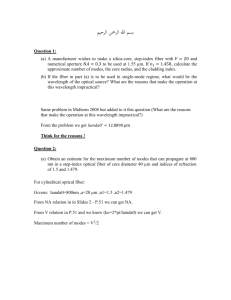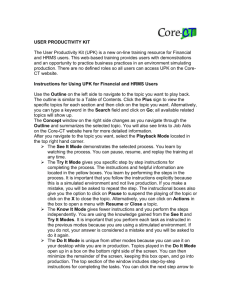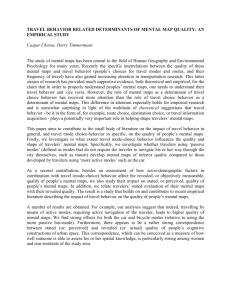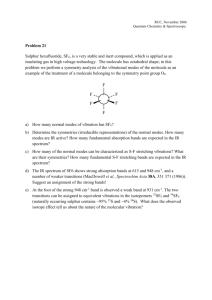Modes of an endlessly single-mode photonic crystal fiber: a finite
advertisement
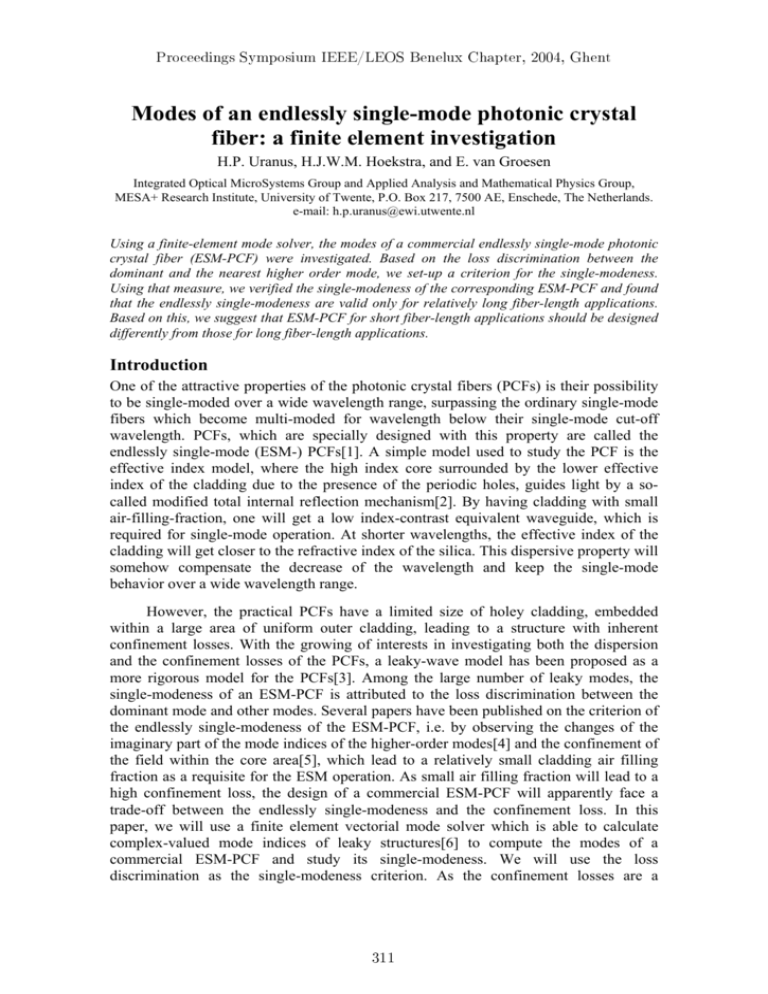
Proceedings Symposium IEEE/LEOS Benelux Chapter, 2004, Ghent Modes of an endlessly single-mode photonic crystal fiber: a finite element investigation H.P. Uranus, H.J.W.M. Hoekstra, and E. van Groesen Integrated Optical MicroSystems Group and Applied Analysis and Mathematical Physics Group, MESA+ Research Institute, University of Twente, P.O. Box 217, 7500 AE, Enschede, The Netherlands. e-mail: h.p.uranus@ewi.utwente.nl Using a finite-element mode solver, the modes of a commercial endlessly single-mode photonic crystal fiber (ESM-PCF) were investigated. Based on the loss discrimination between the dominant and the nearest higher order mode, we set-up a criterion for the single-modeness. Using that measure, we verified the single-modeness of the corresponding ESM-PCF and found that the endlessly single-modeness are valid only for relatively long fiber-length applications. Based on this, we suggest that ESM-PCF for short fiber-length applications should be designed differently from those for long fiber-length applications. Introduction One of the attractive properties of the photonic crystal fibers (PCFs) is their possibility to be single-moded over a wide wavelength range, surpassing the ordinary single-mode fibers which become multi-moded for wavelength below their single-mode cut-off wavelength. PCFs, which are specially designed with this property are called the endlessly single-mode (ESM-) PCFs[1]. A simple model used to study the PCF is the effective index model, where the high index core surrounded by the lower effective index of the cladding due to the presence of the periodic holes, guides light by a socalled modified total internal reflection mechanism[2]. By having cladding with small air-filling-fraction, one will get a low index-contrast equivalent waveguide, which is required for single-mode operation. At shorter wavelengths, the effective index of the cladding will get closer to the refractive index of the silica. This dispersive property will somehow compensate the decrease of the wavelength and keep the single-mode behavior over a wide wavelength range. However, the practical PCFs have a limited size of holey cladding, embedded within a large area of uniform outer cladding, leading to a structure with inherent confinement losses. With the growing of interests in investigating both the dispersion and the confinement losses of the PCFs, a leaky-wave model has been proposed as a more rigorous model for the PCFs[3]. Among the large number of leaky modes, the single-modeness of an ESM-PCF is attributed to the loss discrimination between the dominant mode and other modes. Several papers have been published on the criterion of the endlessly single-modeness of the ESM-PCF, i.e. by observing the changes of the imaginary part of the mode indices of the higher-order modes[4] and the confinement of the field within the core area[5], which lead to a relatively small cladding air filling fraction as a requisite for the ESM operation. As small air filling fraction will lead to a high confinement loss, the design of a commercial ESM-PCF will apparently face a trade-off between the endlessly single-modeness and the confinement loss. In this paper, we will use a finite element vectorial mode solver which is able to calculate complex-valued mode indices of leaky structures[6] to compute the modes of a commercial ESM-PCF and study its single-modeness. We will use the loss discrimination as the single-modeness criterion. As the confinement losses are a 311 Modes of an Endlessly Single-mode Photonic Crystal Fiber: a nite element investigation function of the fiber length, the latter quantity will play an important role in the singlemodeness of the ESM-PCF. Fiber structure We pick-up the ESM-12-01 fiber made by BlazePhotonics[7] as our sample. This commercial PCF is attributed to be endlessly singleair holes mode and suitable for short wavelength applications d by the factory. The structure of the fiber is depicted in Fig. 1, with d=3.68µm and Λ=8µm. Within this silica paper, the refractive index of the undoped silica as the host material has been taken from the Sellmeier’s equation given by Malitson[8], while the Figure 1. The structure of ESM-12refractive index of the air holes is assumed to be 01. constant 1 within the wavelength region of interest. Λ Results and discussions The first-few modes of the considered PCF with attenuation constant of smaller than 10 dB/cm were calculated using a finite element mode solver[6] for wavelength spanning from 0.4µm to 1.6µm. Within this calculation, the material loss is not taken into account. The real and imaginary parts of the mode effective indices are shown in Fig. 2, while the dispersion parameter and the attenuation constant are depicted in Fig. 3. Since the wavelength dependence of the refractive indices of the material has already been taken into account during the mode solving, the dispersion shown here is a combined effect of both material and waveguide dispersion. 1.47 3 x 10 -5 HE -clad 31 1.465 2.5 HE -core-clad 22 1.46 Re(n 1.45 1.435 0.4 02 1.5 TE , TE -core-clad, TM 01 0,2 01 HE , HE -clad, HE -core-clad 21 0.6 31 0.8 1 1.2 1.4 11 TE , HE , TM 0.5 22 0 0.4 1.6 λ (µm) HE HE -clad 1 1.445 1.44 TE -core-clad eff eff ) 11 -Im(n HE 1.455 ) 2 01 0.6 0.8 1 21 1.2 1.4 11 01 1.6 λ (µm) (a) (b) Figure 2. The calculated (a). real and (b). imaginary parts of the effective indices of the first-few modes of the ESM-PCF. In (b), the curve for HE11-like mode almost coincides with the horizontal axis. Fig. 2a shows that the real part of the effective index of the fundamental HE11 like mode is well separated from other modes, indicating the onset of the single-mode behavior, which is stronger for longer wavelength. Fig. 3a shows that the dispersion properties of those modes are dominated by the material dispersion of the bulk silica as the air holes effect is weak due to the small d / Λ ratio. However, looking at the loss properties of the modes (Fig. 2b and 3b), we notice the existence of 3 groups of modes. The first one is the fundamental HE11 -like mode which has very low loss. The second one is the higher order core modes associated with LP11 -like scalar mode, i.e. TE01 -, TM 01 -, and HE21 -like modes. Since the d / Λ is small, the equivalent waveguide is a 312 Proceedings Symposium IEEE/LEOS Benelux Chapter, 2004, Ghent low-index-contrast one, hence the vectorial character of the modes is less pronounced as indicated by the very similar loss properties of these 3 modes. The last group of modes has unusual field distribution. These are the cladding-resonance and the core-claddingresonance modes as depicted in Fig. 4. Their existence can be understood by viewing the holey section of the cladding (including the core) as a defect in the uniform cladding background, hence forming a resonance center. For PCFs with large d / Λ , these resonance modes are far apart from the modes of interest, hence not noticeable. Since they are less confined than the core modes, they are leakier. TE02-core-clad, HE22-core-clad, HE31-clad, HE11-clad 0 Attenuation (dB/cm) Dispersion (ps/(nm ⋅ km)) 200 -200 line : HE , TE , TM , HE , 11 -400 01 01 21 TE -core-clad, HE -core-clad, 02 22 HE -clad, HE -clad -600 31 11 circle: material dispersion -800 -1000 10 TM01, TE01, HE21 10 0.6 0.8 1 1.2 1.4 10 1.6 λ (µm) -5 HE11 Dispersion = - (λ /c) ∂ 2/∂λ 2 [Re(n )] eff -1200 0.4 0 -10 0.4 0.6 (a) 0.8 1 λ (µm) 1.2 1.4 1.6 (b) 30 30 20 20 10 10 y (µm) y (µm) Figure 3. The calculated (a). dispersion parameter and (b). attenuation constant of first-few modes of the ESM-PCF. The curves in (a) almost coincide, indicating the weak waveguide dispersion. 0 0 -10 -10 -20 -20 -30 -30 -20 0 x (µm) (a) 20 -20 0 x (µm) 20 (b) (c) (d) Figure 4. The transverse component of the magnetic field of (a). the HE11-like cladding-resonance and (b). the HE22-like core-cladding-resonance modes and (c) & (d) the longitudinal component of their time-averaged Poynting vectors as calculated at λ=1µm. The single-modeness of the ESM-PCF can be evaluated by comparing the difference in confinement losses between the dominant mode and the nearest higher order modes. We define a quantity called multi-mode rejection ratio (MMRR) as a measure of the single-modeness as follows. MMRR = 10log ( P0 P1 ) = (α1 − α 0 ) L with P0 and P1 denoting the power of the dominant fundamental and the nearest higherorder mode (which are assumed to be equally excited), while α0, α1, and L denoting the attenuation constant of the dominant mode, the nearest higher-order mode, and the length of the fiber, respectively. By putting 20dB as the minimum MMRR (meaning that the power of the fundamental mode is at least 100 times larger than the nearest higher order mode) as the single-modeness criterion, we get the minimum length of the fiber for single mode operation are 11.97m, 3.86m, and 0.78m for wavelength of 0.4µm, 313 Modes of an Endlessly Single-mode Photonic Crystal Fiber: a nite element investigation 0.6328µm, and 1µm, respectively, as shown in Fig. 5. Allowing the power of the fundamental mode to be just at least 10 times the nearest higher order mode, the minimum length is just half of those of the previous criterion. Hence, MMRR =10 dB although this fiber geometry does not fulfill the ESM criterion of Mortensen et al.[5], it still can be regarded as ESM-PCF for long MMRR =20 dB fiber-length applications. While, for short fiber-length applications (e.g. if one think of gas/liquid sensing applications), especially for λ (µm) short wavelength region, the endlessly singleFigure 5. Minimum fiber length for modeness should be considered with some single-mode operation by the precaution. Although the attenuation of the loss discrimination criterion for fundamental mode is 6 orders lower (in dB minimum MMRR of 10 and 20 dB. scale) than the nearest higher order modes, the low attenuation of these higher order modes can make them to be significant for these particular applications. This suggests the requirement of ESM-PCF which is specially designed for short fiber-length applications. As these applications can tolerate higher attenuation, the use of smaller d / Λ and less rings of air holes can be incorporated. Otherwise, some manner to strip off higher order modes might be required. 12 Minimum fiber length (m) 10 8 min 6 4 min 2 0 0.4 0.6 0.8 1 1.2 1.4 1.6 Conclusions The modes of a commercial ESM-PCF were investigated using a finite-element-based vectorial mode solver. Based on the loss discrimination, the single-modeness of the PCF were verified, which suggests that ESM-PCF for short and long fiber-length applications should be designed differently. Acknowledgements This work is supported by STW Technology Foundation through project TWI.4813. References [1] T.A. Birks, J.C. Knight, and P. St. J. Russell, "Endlessly single-mode photonic crystal fiber,” Opt. Lett., Vol. 22, No. 13, pp. 961-963, 1997. [2] P. Russell, “Photonic crystal fibers,” Science, Vol. 299, pp. 358-362, 2003. [3] T.P. White et al., “Confinement losses in microstructured optical fibers,” Opt. Lett., Vol. 26, pp. 1660-1662, 2001. [4] B.T. Kuhlmey, R.C. McPhedran, and C.M. de Sterke, “Modal cutoff in microstructured optical fibers,” Opt. Lett., Vol. 27, No. 19, pp. 1684-1686, 2002. [5] N.A. Mortensen et al., “Modal cutoff and the V parameter in photonic crystal fibers,” Opt. Lett., Vol. 28, No. 20, pp. 1879-1881, 2003. [6] H.P. Uranus and H.J.W.M. Hoekstra, “Modelling of microstructured waveguides using a finiteelement-based vectorial mode solver with transparent boundary conditions,” Opt. Express, Vol. 12, No. 12, pp. 2795-2809, 2004. [7] http://www.blazephotonics.com/pdf/ESM%20-%2012%20-%2001.pdf [8] I.H. Malitson, “Interspecimen comparison of the refractive index of fused silica,” J. Opt. Soc. Am., Vol. 55, pp. 1205-1209, 1965. 314

